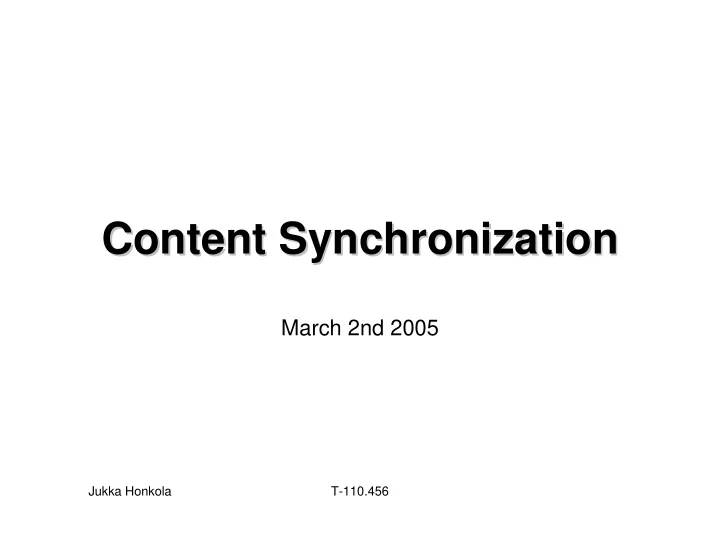

Content Synchronization Content Synchronization March 2nd 2005 Jukka Honkola T-110.456
Synchronization Synchronization • Needed whenever multiple copies of an object may be updated independently • After synchronization objects should be in same state • Conflict resolution • Domain specific solutions • Can be often automated Jukka Honkola T-110.456
Different types of synchronization Different types of synchronization • One way or two way • Slow • Transmit all information • Slow • Fast • Transmit only changes • Devices need to keep track of all changes Jukka Honkola T-110.456
Issues with mobile devices Issues with mobile devices • The usual suspects: • Electric power, computing power, slow connections, limited data storage • Divide the synchronization workload asymmetrically • Client / server, server doing most of the work • Client still needs to track changes • Standard solution: SyncML • Defines data representation and synchronization protocol Jukka Honkola T-110.456
SyncML - - Overview Overview SyncML • Can be used with different bearers • Radio, Bluetooth, Infrared, WLAN... • Messages are in XML • WBXML used to save bandwidth • Synchronization protocol • Initialization • Negotiate capabilities between client & server • Negotiate sync type • Authentication • Data transfer Jukka Honkola T-110.456
Example synchronization Example synchronization Jukka Honkola T-110.456
SyncML - - synchronization types synchronization types SyncML • Seven different synchronization types • Slow / fast two-way • Slow / fast one-way from client to server • Slow / fast one-way from server to client • Server initiated sync • Normally, client always initiates sync • Server can request initiation from client • The two-way syncs are required by the standard, others are optional Jukka Honkola T-110.456
SyncML - - message structure message structure SyncML • Information is transferred in packages • Packages can consist of multiple messages • Message size can be limited by the bearer • Large objects may be sent in multiple messages • Package contains related information • e.g. client modifications, initialization Jukka Honkola T-110.456
SyncML - - conflict resolution conflict resolution SyncML • SyncML does not define how conflicts are resolved • Out of scope as resolving is domain-specific • Mechanism for reporting conflicts and actions taken • Status codes for different types of conflicts • delete, update • Status codes for outcomes • Server win, client win, merge, copy • Conflicts are resolved in the server Jukka Honkola T-110.456
SyncML - - mappings mappings SyncML • Server identifiers are typically long while mobile terminals will benefit from shorter identifiers • SyncML uses two sets of identifiers: • GUID: Globally Unique IDentifier • LUID: Locally Unique IDentifier • Client always uses LUIDs, and server maintains a mapping between LUIDs and GUIDs. Jukka Honkola T-110.456
Example ID mapping Example ID mapping Jukka Honkola T-110.456
SyncML - - device capabilities device capabilities SyncML • There is a DTD defining the device capability description • Exchanging capability information is useful • Server can avoid sending information that the client can not use • Removes possible sources of ambiguity • For example, if client sends a contact entry without a picture, was the picture deleted deliberately or discarded because client does not support pictures Jukka Honkola T-110.456
SyncML - - miscellaneous miscellaneous SyncML • Sync anchors next and last • Provides a way to see if an attempt failed • Some error cases require slow sync • If database contains large items, such as photographs, this can be wasteful as also unchanged data is transmitted • In some cases message digests could be used to save bandwidth Jukka Honkola T-110.456
Using digests to save bandwidth Using digests to save bandwidth • General idea: • Client sends digests of all items to server • Server compares received digests to stored information and deduces the changes made by client • Server sends changed items to client and requests changed items from client • Server reconstructs the change log regarding changed items in order to avoid sending unchanged information • Not supported in the standard • Utility depends on many factors • Frequency errors requiring slow sync • Amount of large items in databases Jukka Honkola T-110.456
Recommend
More recommend